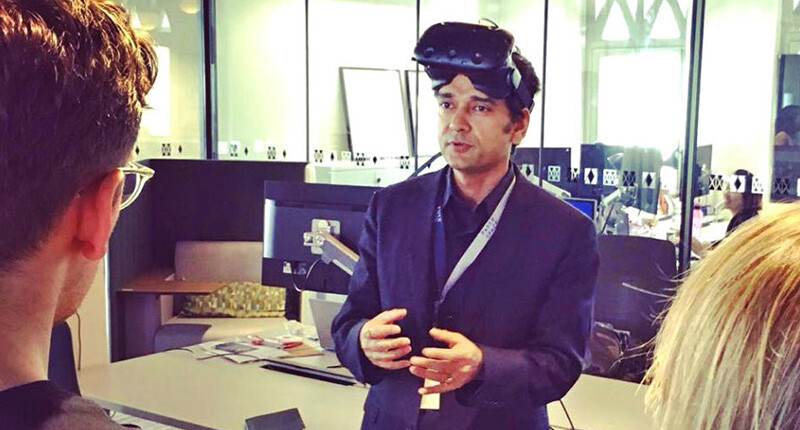Let me start with a fundamental question: why Trezi? And why a product for the AEC industry?
Hi. To answer your question, SmartVizX, the organization that created Trezi, has intrinsically been an architecture and design-focused company since its inception. Both Tithi and I are architects with over four decades of combined experience. The problems we are solving are actually problems we have faced right through our professional careers. We do not want to solve these challenges only for ourselves because our passion and critical focus is on solving the problem for the entire industry.
Having faced issues due to limited and static tools as a means to communicate our designs to clients, we conceptualized Trezi. Trezi is a Virtual Reality solution, a culmination of architects struggling to explain their design ideas with 2D layouts and static 3D stills created using 3d rendering software, which repeatedly results in errors creeping into construction. And this is when clients really start losing serious money – in sorting out mistakes that could have been avoided right at the beginning. We wanted our clients (owners and tenants of offices and homes) to be actively involved in the design process so as to prevent any misunderstanding between the stakeholders vis-a-vis vision of the designers, and to manage expectations better.
Where does Virtual Reality come into play here?
The key was to provide the opportunity to immerse the user and buyer into the designed environments and architecture models. We chose Virtual Reality after some serious – discussions with a number of game developers who had an innate understanding of game engines like Unity3d or Unreal. We were now able to understand the potential of Virtual Reality in architecture and the impact it could have on the way visualization and collaboration were happening in the AEC industry. It just felt completely natural and intuitive: it was like being there and seeing the future unfold. Virtual Reality helps make designs more immersive and the communication two-way instead of one-way traffic between the designer and the client.
Challenges faced while introducing Trezi to the market
There were significant challenges that came our way. When we started we wanted to provide the opportunity to design within Virtual Reality. But early feedback from the market suggested that architects and designers were not ready for a complete paradigm shift. Existing 3D architecture software had to be supported for ease of adoption.
Then the lack of standard tools was the other challenge: there are so many products that are currently used by the fraternity and practically everyone has their own ways of using them, contributing to massive time and cost losses. We decided to work with the most commonly used products to maximize adoption.
Also, there were challenges around VR too, which is still largely a very new technology. We consciously decided on starting in a service mode to understand the tech and customer behavior as much as possible. Once we felt confident with it and gained an understanding of user needs, behavior, adjacent markets, and other valuable insights, we bit the bullet and pivoted into the product journey.
The important thing to understand here is that Trezi is a product for the future. We believe, and the fraternity has validated, too, that immersive design, visualization, and collaboration is the future. The 2D way of working in design will not last too long.
Let us talk about the traditional design process and how Trezi aims to reduce it
Current processes do not facilitate real-time collaboration and decision making… which is exactly what Trezi does.
Using the power of Immersive computing and applying Virtual Reality on real-world projects with Trezi, we can actually reduce the stages of design.
The traditional design process is as follows –
The Concept stage involves architects who pen down their vision in pen and paper using various tools, including sketching. Once the concept is finalized, the architect moves on to a Schematic Design that gives shape to the concept with more real-time considerations being responded to at this stage. The final stage of any project is the Design Development when plans, layouts, sections, and elevations get finalized along with building services.
While the time taken in each stage is significant, one of the biggest risks is that of a lack of common understanding due to different levels of interpretations by different stakeholders. This gap between expectations has been the bane of the architecture and design industry.
With Virtual Reality, we are able to bring all stakeholders on the same level of understanding by creating a virtual meeting platform for the AEC industry, and even decrease the time taken to finalize design through traditional processes by immersive design, thus ensuring far better collaboration. The projects not only come out better but the time for creating renders takes seconds (some are even instantaneous). This is a huge change from days and weeks that they took earlier. The designs are also what the client had ‘truly understood’ since, in this case, the client was a contributing stakeholder through virtual tours of the architecture models and could actively view and suggest changes in Virtual reality.
Trezi: Going beyond just architects
Well, at this point, we aim to bring more architects and designers onto the platform. But in the very near future (in fact the onboarding has commenced already) with a critical mass of architects on Trezi, we will bring building product suppliers on the platform too and allow architects and designers, customers and suppliers to actively engage with each other in real-time. This will be a platform for vendors to showcase their products and avoid physical mockups and catalogs using the power of immersive visualization.
Architects will reduce errors, eliminate gaps in understanding and complete projects earlier, thereby saving a significant amount of time and resources. The advantages are numerous and those who have tried our product have given us very positive feedback.
Try out Trezi as an architect
If you are an architect, please try Trezi right away. We have a free trial and if your system supports Oculus Rift or HTC Vive, then we would love to get your feedback on. Trezi was created to solve the problems of architects and designers and help them collaborate with building product suppliers and customers in real-time. Each and every feedback means a lot to us as we continually improve the product. We do our best to incorporate every relevant feedback in the product for the benefit of the entire industry. Our agile methodology of product development is committed to providing regular updates and new features in Trezi with every new release. We aim to make Trezi the go-to software for all AEC stakeholders going forward and are focussed on the workplace segment to start with as that is where founders come from but subsequent releases will incorporate other design specialties too.
To experience a free 14-day trial using your own SteamVR-compatible Virtual Reality kit, please sign up here.
Or contact us to organize a demo at your office – our sales representative will set up an appointment at your convenience.












